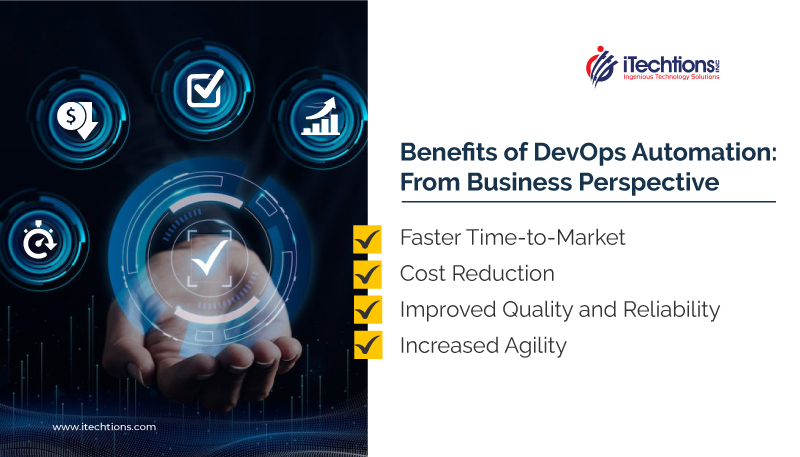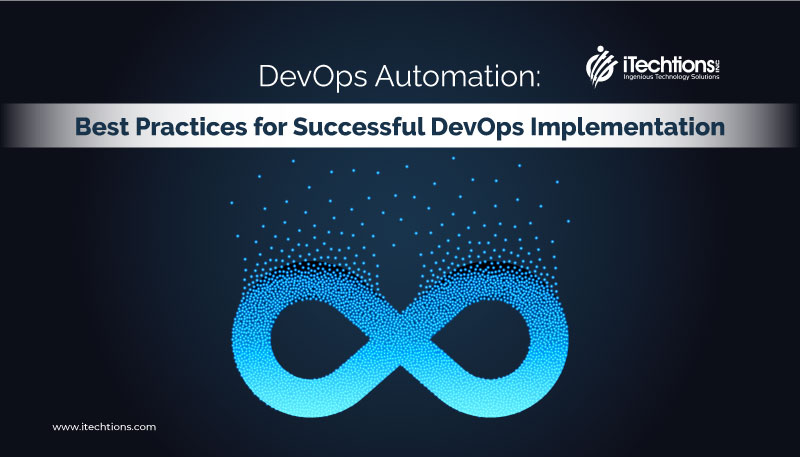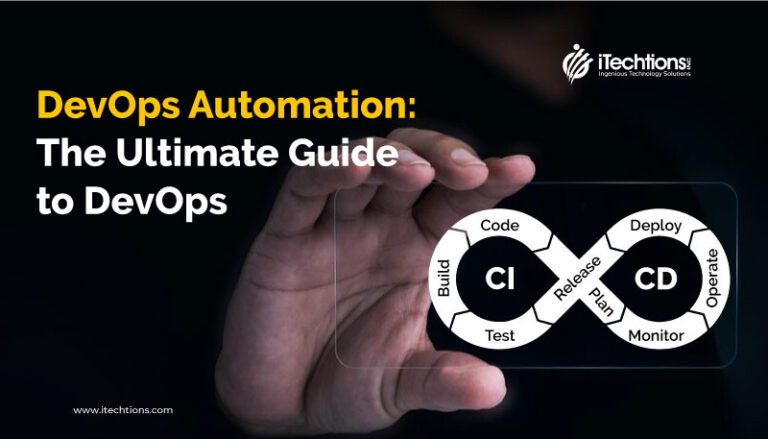Introduction
In today’s fast-paced digital landscape, DevOps automation has become a crucial component for businesses striving to enhance their software delivery processes and achieve operational efficiency. With the arrival of 2022, it’s essential to stay updated on the latest best practices that can help your business thrive in the realm of DevOps automation.
In this blog, we will explore the key strategies and approaches that can empower your organization to streamline workflows, reduce manual efforts, and drive innovation through automation.
-
- Embracing Infrastructure as Code (IaC):
One of the foundational elements of successful DevOps automation is adopting Infrastructure as Code. By treating infrastructure provisioning, configuration, and management as code, you can achieve consistent, scalable, and repeatable environments. We’ll discuss the benefits of IaC and delve into popular tools such as Terraform and AWS CloudFormation that facilitate infrastructure automation.
- Embracing Infrastructure as Code (IaC):
-
- Continuous Integration and Continuous Deployment (CI/CD) Pipelines:
Implementing robust CI/CD pipelines enables you to automate the build, test, and deployment processes. We’ll explore best practices for designing efficient pipelines, integrating automated testing frameworks, and leveraging containerization technologies like Docker and Kubernetes to ensure seamless software delivery.
- Continuous Integration and Continuous Deployment (CI/CD) Pipelines:
-
- Configuration Management with Tools like Ansible and Puppet:
Efficiently managing configuration across multiple environments is critical for maintaining consistency and reducing errors. We’ll highlight the significance of configuration management tools such as Ansible and Puppet, and discuss how to automate configuration deployment, enforce compliance, and handle infrastructure drift.
- Configuration Management with Tools like Ansible and Puppet:
-
- Monitoring and Alerting Automation:
Proactive monitoring and timely alerts are vital for identifying and resolving issues promptly. We’ll dive into monitoring automation tools like Prometheus and Grafana, and explore strategies for automating alert generation, incident response, and self-healing systems.
- Monitoring and Alerting Automation:
-
- Security Automation:
Security should be an integral part of your DevOps automation strategy. We’ll explore techniques for automating security testing, vulnerability scanning, and compliance checks. Additionally, we’ll discuss the importance of integrating security into the CI/CD pipelines and leveraging tools like SonarQube and OWASP ZAP.
- Security Automation:
-
- Collaboration and Communication Automation:
Effective collaboration and communication are crucial for successful DevOps practices. We’ll examine automation tools such as Slack, Microsoft Teams, and Jira, which facilitate seamless communication, task tracking, and issue resolution across development and operations teams.
- Collaboration and Communication Automation:
Why do you need DevOps Automation?
DevOps automation offers numerous benefits that can greatly enhance the efficiency and effectiveness of software development and operations processes. DevOps automation brings numerous benefits to both engineering and business aspects of an organization. It enables speed, efficiency, consistency, scalability, improved collaboration, and continuous improvement, ultimately leading to faster time-to-market, cost reduction, improved quality, and increased agility. By embracing DevOps automation, businesses can stay competitive, deliver value to customers more effectively, and achieve their strategic goals.
From an engineering perspective, here are some benefits of DevOps automation:

-
- Speed and Efficiency: Automation allows for faster and more efficient software delivery. Tasks that are prone to human error or require repetitive manual work can be automated, saving time and reducing the risk of mistakes. Automated build, test, and deployment processes enable rapid and reliable delivery of software, leading to shorter development cycles and faster time-to-market.
-
- Consistency and Reliability: Automation ensures consistent and repeatable processes across different environments. By defining infrastructure, configurations, and deployment pipelines as code, teams can ensure that every deployment follows the same steps and configurations. This reduces the risk of configuration drift and increases the reliability and stability of software deployments.
-
- Scalability and Flexibility: With automation, it becomes easier to scale infrastructure and handle increased workloads. Automated provisioning and configuration management allow for the quick and efficient creation of new environments, enabling teams to respond to changing demands and handle spikes in traffic or workload without manual intervention.
-
- Improved Collaboration: DevOps automation promotes collaboration and communication between development, operations, and other teams involved in the software delivery process. By automating workflows and using collaboration tools, teams can work together seamlessly, share information, and resolve issues more effectively. This fosters a culture of collaboration and breaks down silos between teams, leading to better overall outcomes.
-
- Continuous Feedback and Continuous Improvement: Automation enables the collection of metrics and data throughout the software development lifecycle. This feedback loop provides valuable insights into the performance, quality, and user experience of the software. Teams can use this data to identify areas for improvement, optimize processes, and make data-driven decisions to enhance the software delivery pipeline continuously.
From a business perspective, the benefits of DevOps automation include:

-
- Faster Time-to-Market: Automation enables faster delivery of software, allowing businesses to release new features, updates, and bug fixes to customers more quickly. This provides a competitive advantage by responding to market demands and customer needs on time.
-
- Cost Reduction: Automation reduces the need for manual, repetitive tasks, which can be time-consuming and prone to errors. By automating these tasks, businesses can optimize resource allocation, reduce operational costs, and free up teams to focus on higher-value activities.
-
- Improved Quality and Reliability: Automated testing and deployment processes help ensure that software releases are of high quality and reliable. By automating tests, businesses can catch bugs and issues early in the development cycle, resulting in better quality software and a more positive user experience.
-
- Increased Agility: Automation enables businesses to respond quickly to changes in the market and customer requirements. With streamlined processes and automated infrastructure, businesses can adapt and scale their software delivery to meet evolving needs, allowing for faster innovation and quicker responses to market opportunities.
Best DevOps Automation Practices: What and How to Automate?
When implementing DevOps automation, it’s important to consider which areas and processes to automate. While the specific automation needs may vary depending on the organization and its goals, here are some common areas and practices to consider automating:
-
- Continuous Integration and Continuous Deployment (CI/CD):
Automate the build, test, and deployment processes to ensure rapid and reliable software delivery. This includes automating code compilation, running unit tests, packaging artifacts, and deploying them to various environments. Tools like Jenkins, GitLab CI/CD, and CircleCI can help in setting up and automating CI/CD pipelines.
- Continuous Integration and Continuous Deployment (CI/CD):
-
- Infrastructure as Code (IaC):
Adopt Infrastructure as Code principles to automate infrastructure provisioning and configuration. Tools like Terraform and AWS CloudFormation enable defining infrastructure resources in a declarative manner, allowing for consistent and reproducible deployments across environments.
- Infrastructure as Code (IaC):
-
- Configuration Management:
Automate the management and configuration of software and infrastructure components. Tools like Ansible, Puppet, or Chef can help in automating the deployment and configuration of servers, services, and applications, ensuring consistency and reducing manual effort.
- Configuration Management:
-
- Testing and Quality Assurance:
Automate various types of testing, such as unit tests, integration tests, and end-to-end tests. This includes using frameworks like Selenium or Cypress for automated UI testing, JUnit or NUnit for unit testing, and tools like SonarQube for code quality analysis. Automated testing ensures faster feedback and helps maintain software quality.
- Testing and Quality Assurance:
-
- Monitoring and Alerting:
Automate the monitoring of applications and infrastructure to detect and respond to issues promptly. Use monitoring tools like Prometheus, Grafana, or Datadog to collect and analyze metrics, set up alerts, and trigger automated actions or notifications when thresholds are breached.
- Monitoring and Alerting:
-
- Release Management:
Automate the release process to streamline deployments across different environments. This includes automating the promotion of artifacts from one environment to another, managing release configurations, and ensuring consistency across environments using tools like Spinnaker or Octopus Deploy.
- Release Management:
-
- Security and Compliance:
Automate security testing and compliance checks to ensure that software meets the required security standards. Use tools like SonarQube, OWASP ZAP, or Snyk for static code analysis, vulnerability scanning, and dependency management. Automate security checks as part of the CI/CD pipeline to identify and resolve security issues early in the development process.
- Security and Compliance:
-
- Incident Response and Remediation:
Automate incident response processes by setting up automated workflows for detecting, diagnosing, and resolving incidents. Use tools like PagerDuty, VictorOps, or Ops-genie to manage incidents, automate notifications, and trigger automated actions or remediation scripts when incidents occur.
- Incident Response and Remediation:
-
- Collaboration and Communication:
Automate collaboration and communication between teams by leveraging tools like Slack, Microsoft Teams, or Atlassian Jira. Set up notifications, alerts, and integrations to keep teams informed about build statuses, deployments, and other relevant updates.
- Collaboration and Communication:
When deciding what to automate, consider the areas that would benefit the most from automation in terms of efficiency, reliability, and impact on the software delivery lifecycle. Start with smaller, manageable automation tasks and gradually expand to more complex processes. Remember to evaluate regularly and refine your automation practices to adapt to changing needs and technologies.
Bottom Line
DevOps automation is a crucial aspect of modern software delivery and operations. By embracing best practices in DevOps automation, businesses can achieve increased speed, efficiency, consistency, scalability, and collaboration throughout the software development lifecycle. Some key takeaways for implementing successful DevOps automation in 2023 are:
-
- Embrace Infrastructure as Code (IaC) to ensure consistent and scalable environments.
-
- Implement robust Continuous Integration and Continuous Deployment (CI/CD) pipelines for faster and reliable software delivery.
-
- Automate configuration management to reduce errors and maintain consistency across environments.
-
- Use monitoring and alerting automation to detect proactively and respond to issues.
-
- Incorporate security automation to ensure the integrity and compliance of software.
-
- Leverage collaboration and communication automation tools for effective team collaboration.
-
- Continuously gather feedback and use data-driven insights for continuous improvement.
By following these best practices, businesses can unlock the full potential of DevOps automation, streamline their processes, deliver high-quality software faster, and stay ahead in the competitive market landscape of 2023 and beyond.
Final Thoughts
DevOps is projected to improve more in the years to come. It has been anticipated that security will be included from the start due to the broad adoption of DevSecOps. This has gotten more attention as a result of the rising popularity of remote work and the consequent increase in security concerns businesses face.
Another forecast is that businesspeople will join the team and work more closely together to help organisations adapt to the digital age. Citizen developers can create entire interfaces and fix integration problems within the same platform by working directly using low code automation tools.
The DevOps ecosystem will become even more automated as a result of autonomous DevOps automation. It is a robotic process automation tool that helps automate labour-intensive manual tasks in order to boost production in all areas. As a result, when combined with AIOps, which provides seamless operational feedback and autonomous problem solutions, the majority of human involvement will be minimised.









